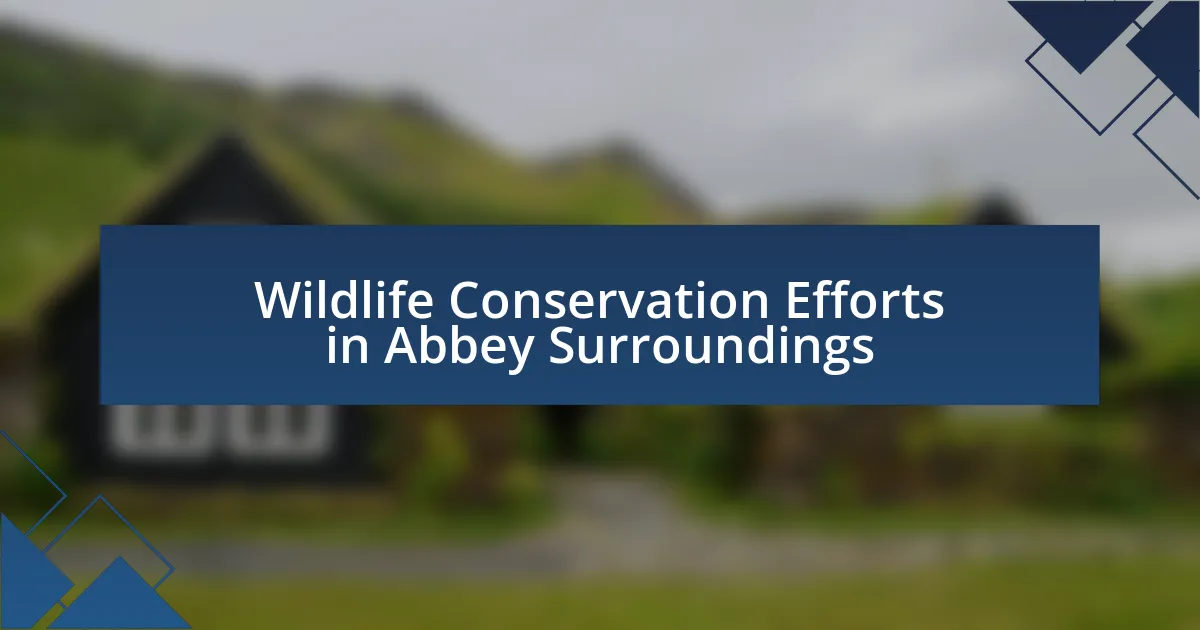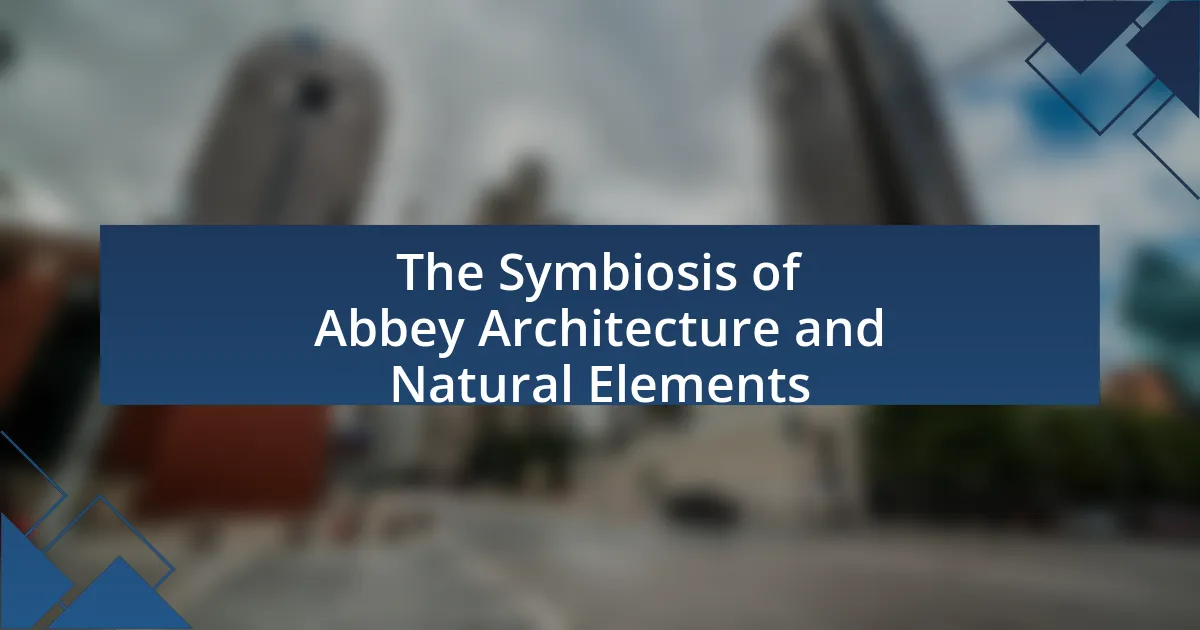The article examines the significance of natural landscapes in the construction of historic abbeys, highlighting how these environments foster spiritual reflection and community living. It discusses the influence of topography, water sources, vegetation, and climate on site selection and architectural design, emphasizing the use of local materials that harmonize with the surroundings. The article also explores the cultural and spiritual connections between abbeys and their landscapes, the challenges posed by natural environments for maintenance, and best practices for integrating these landscapes in restoration projects. Additionally, it addresses the role of conservation efforts in preserving the integrity of abbey landscapes, ensuring their historical and ecological values are maintained.

What is the significance of natural landscapes in the construction of historic abbeys?
Natural landscapes play a crucial role in the construction of historic abbeys by providing a serene environment that fosters spiritual reflection and community living. The selection of sites often emphasizes natural features such as hills, rivers, and forests, which not only enhance the aesthetic appeal but also symbolize the connection between the divine and nature. For instance, many abbeys were built in remote areas to promote solitude and contemplation, aligning with monastic values. Historical examples include the Abbey of Mont-Saint-Michel in France, which is situated on a rocky island, emphasizing its isolation and spiritual significance. Additionally, the natural landscape often influenced architectural design, as seen in the use of local materials that harmonize with the surroundings, further embedding the abbey within its environment.
How do natural landscapes influence the architectural design of abbeys?
Natural landscapes significantly influence the architectural design of abbeys by dictating their orientation, materials, and overall aesthetic. The positioning of abbeys often aligns with natural features such as hills, rivers, or forests, which not only enhances their spiritual ambiance but also provides practical benefits like natural protection and access to resources. For instance, many abbeys are built on elevated ground to symbolize a connection to the divine, as seen in the case of Mont Saint-Michel in France, which is situated on a rocky island. Additionally, local materials sourced from the surrounding landscape, such as stone or timber, are commonly used in construction, ensuring that the abbey harmonizes with its environment. This integration of natural elements into the design reflects the historical context of monastic life, where the relationship between nature and spirituality was paramount.
What specific landscape features are considered in abbey construction?
Specific landscape features considered in abbey construction include topography, water sources, vegetation, and climate. Topography influences the site selection, as abbeys are often built on elevated ground for visibility and defense. Proximity to water sources, such as rivers or springs, is crucial for sustenance and agriculture, which historically supported monastic communities. Vegetation, including forests and fields, provides resources for building materials and food. Additionally, the local climate affects the architectural design and materials used, ensuring the abbey’s durability and comfort for its inhabitants. These features collectively contribute to the functional and spiritual aspects of abbey construction, reflecting the harmony between the built environment and nature.
How does the surrounding environment affect the materials used in abbey building?
The surrounding environment significantly influences the materials used in abbey building by determining the availability and suitability of local resources. For instance, in regions with abundant limestone, such as the Cotswolds in England, builders historically utilized this material for its durability and ease of carving, as seen in the construction of the famous Cotswold abbeys. Additionally, the climate affects material choices; in wetter areas, builders might opt for slate or granite, which resist moisture better than other materials. Historical records indicate that abbeys in coastal regions often incorporated local stone and timber, reflecting the immediate environment’s resources and conditions. Thus, the interplay between local geology, climate, and resource availability directly shapes the architectural choices in abbey construction.
Why were abbeys historically built in specific natural settings?
Abbeys were historically built in specific natural settings to enhance spiritual contemplation and provide a peaceful environment conducive to monastic life. The choice of location often included remote areas, such as valleys or hillsides, which offered natural beauty and isolation from worldly distractions. For instance, many abbeys were constructed near water sources, such as rivers or lakes, which not only provided essential resources but also symbolized purity and tranquility, aligning with the spiritual goals of the monastic community. Historical examples include the Abbey of Cluny in France, situated in a serene valley, which facilitated a focus on prayer and community life, reflecting the architectural and spiritual intentions of the time.
What role did geography play in the selection of abbey locations?
Geography significantly influenced the selection of abbey locations by providing essential resources, strategic advantages, and spiritual symbolism. Abbeys were often situated near water sources for drinking and agriculture, as seen in the establishment of the Abbey of Cluny near the River Grosne, which facilitated farming and transportation. Additionally, elevated locations offered natural defense against invasions, exemplified by the positioning of Mont Saint-Michel on a rocky island. The surrounding landscapes also held spiritual significance, with many abbeys built in serene, remote areas to promote contemplation and connection with nature, as demonstrated by the Cistercian order’s preference for secluded sites. Thus, geography played a crucial role in ensuring the sustainability, security, and spiritual purpose of abbey locations.
How did natural resources impact the establishment of abbeys?
Natural resources significantly influenced the establishment of abbeys by providing essential materials and sustenance for monastic communities. The availability of timber, stone, and fertile land allowed for the construction of durable structures and the cultivation of crops, which were vital for the self-sufficiency of these religious institutions. For instance, many abbeys were built near forests for timber and quarries for stone, facilitating easier access to construction materials. Additionally, proximity to water sources enabled the development of mills and irrigation systems, enhancing agricultural productivity. Historical examples include the Cistercian abbeys, which were often strategically located in areas rich in natural resources to support their austere lifestyle and economic independence.
What cultural and spiritual connections exist between abbeys and their landscapes?
Abbeys are deeply intertwined with their landscapes, reflecting cultural and spiritual connections that enhance their significance. The choice of location for abbeys often aligns with natural features such as mountains, rivers, or forests, which are seen as manifestations of divine creation, fostering a sense of peace and contemplation. For example, the Cistercian order, known for its emphasis on simplicity and nature, strategically built abbeys in remote areas to promote spiritual solitude and connection with God. Historical records indicate that the landscapes surrounding these abbeys were often cultivated to support monastic life, with gardens and fields symbolizing the harmony between human effort and divine providence. This relationship between abbeys and their landscapes not only served practical purposes but also reinforced the spiritual mission of the monastic community, creating a sacred space that embodies both cultural heritage and religious devotion.
How do natural landscapes enhance the spiritual experience of abbey visitors?
Natural landscapes enhance the spiritual experience of abbey visitors by providing a serene and contemplative environment that fosters reflection and connection to nature. The tranquility of natural settings, such as forests, mountains, and rivers, creates a backdrop that encourages visitors to engage in spiritual practices like meditation and prayer. Studies have shown that exposure to natural landscapes can reduce stress and promote feelings of peace, which are essential for spiritual experiences. For instance, research published in the Journal of Environmental Psychology indicates that natural environments can enhance emotional well-being and facilitate a deeper sense of spirituality among individuals. This connection to the natural world, combined with the architectural beauty of abbeys, amplifies the overall spiritual experience for visitors.
What historical beliefs influenced the choice of landscape for abbey sites?
The choice of landscape for abbey sites was significantly influenced by historical beliefs regarding spirituality, isolation, and the divine connection to nature. Monastic communities sought locations that embodied tranquility and separation from worldly distractions, often selecting remote or serene landscapes to facilitate contemplation and prayer. For instance, the belief that natural features such as rivers, mountains, and forests were manifestations of God’s creation led to the preference for sites that showcased these elements, reinforcing the idea of a sacred space. Additionally, the historical belief in the healing and purifying qualities of nature further guided the selection of landscapes that were perceived as spiritually uplifting, aligning with the monastic goal of achieving a closer relationship with the divine.
How do natural landscapes contribute to the preservation of historic abbeys?
Natural landscapes contribute to the preservation of historic abbeys by providing a protective environment that mitigates erosion and weathering. The natural topography, including hills and forests, acts as a barrier against harsh weather conditions, reducing the impact of wind and rain on the structures. Additionally, the presence of vegetation helps to stabilize soil and prevent landslides, which can threaten the integrity of abbey foundations. For example, many abbeys built in secluded valleys benefit from the surrounding landscape that naturally shields them from environmental degradation, thereby enhancing their longevity and structural stability.
What challenges do natural landscapes pose for the maintenance of abbeys?
Natural landscapes pose several challenges for the maintenance of abbeys, primarily due to erosion, vegetation growth, and climate impacts. Erosion can undermine the structural integrity of abbey foundations, particularly in areas with steep terrain or heavy rainfall, leading to costly repairs. Additionally, unchecked vegetation growth can damage stonework and roofs, as roots penetrate and expand, causing further deterioration. Climate impacts, such as increased flooding or temperature fluctuations, can exacerbate these issues, making it difficult to preserve the historical architecture. These factors necessitate ongoing maintenance efforts and specialized conservation techniques to ensure the longevity of abbeys situated within natural landscapes.
What are the best practices for integrating natural landscapes in abbey restoration projects?
The best practices for integrating natural landscapes in abbey restoration projects include conducting thorough site assessments, utilizing native plant species, and ensuring ecological sustainability. Site assessments help identify existing natural features and historical landscape designs, which inform restoration efforts. Using native plant species promotes biodiversity and aligns with the historical context of the abbey’s original landscape, as many historic abbeys were designed to harmonize with their natural surroundings. Additionally, implementing sustainable practices, such as rainwater harvesting and organic gardening, supports the ecological integrity of the site while preserving its historical significance. These practices are supported by studies indicating that integrating natural landscapes enhances the aesthetic and cultural value of restoration projects.
How can modern techniques enhance the relationship between abbeys and their landscapes?
Modern techniques can enhance the relationship between abbeys and their landscapes through the use of advanced mapping technologies, sustainable landscaping practices, and ecological restoration methods. Geographic Information Systems (GIS) allow for precise mapping of the abbey’s surroundings, enabling better planning and integration with the natural environment. Sustainable landscaping practices, such as native plant restoration and permaculture, promote biodiversity and reduce maintenance costs, creating a harmonious coexistence between the abbey and its landscape. Additionally, ecological restoration techniques can rehabilitate degraded areas around abbeys, improving the overall aesthetic and ecological health of the site. These methods not only preserve the historical significance of abbeys but also enhance their environmental context, fostering a deeper connection between cultural heritage and natural landscapes.
What role do conservation efforts play in maintaining the integrity of abbey landscapes?
Conservation efforts play a crucial role in maintaining the integrity of abbey landscapes by preserving their historical, ecological, and aesthetic values. These efforts ensure that the natural surroundings, which are integral to the identity and function of abbeys, remain intact and sustainable. For instance, initiatives such as habitat restoration, invasive species management, and sustainable land use practices help protect the biodiversity that supports the cultural heritage of these sites. Additionally, conservation programs often involve community engagement and education, fostering a sense of stewardship among local populations, which is essential for the long-term preservation of abbey landscapes.





